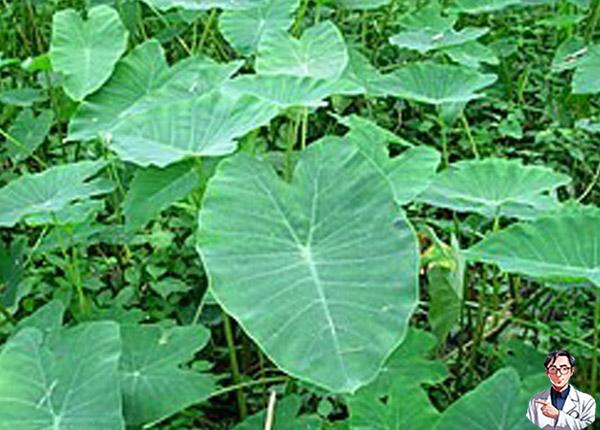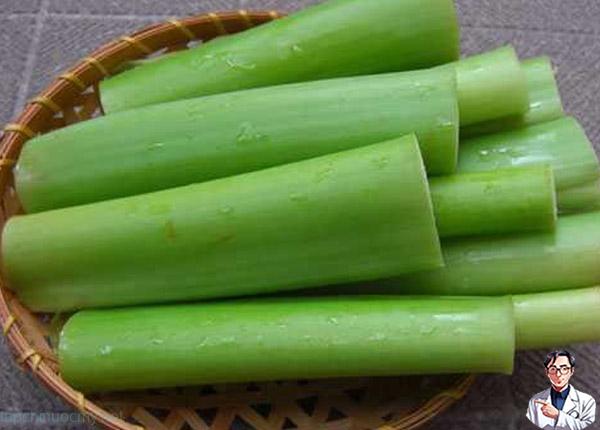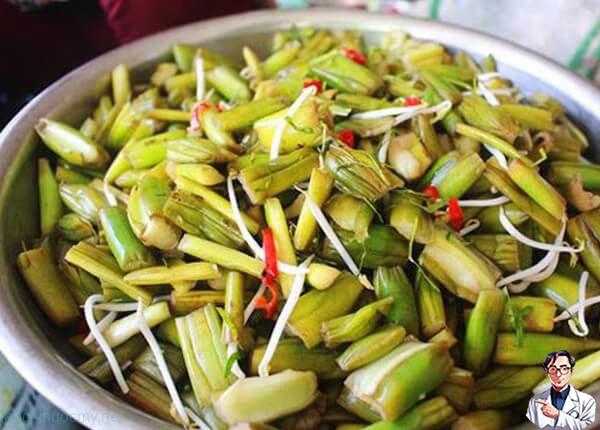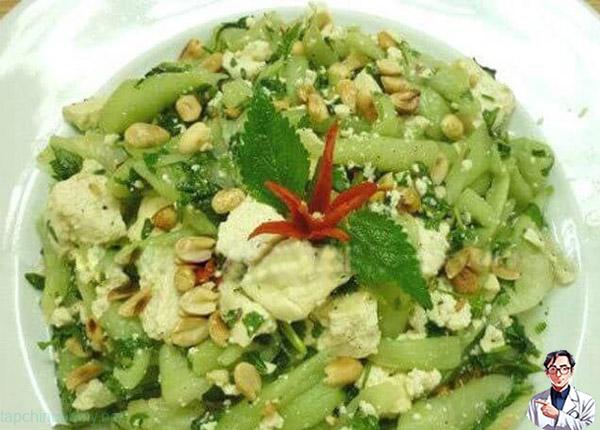
Tips for braising fish so it doesn't smell fishy and cooks quickly. It's delicious whether you braise sea fish or freshwater fish.

The Elephant Ear Plant (Colocasia gigantea): Nutritional Values, Health Benefits, and Usage Precautions
(Presented by a lecturer from Pasteur College of Medicine and Pharmacy)
1. General Characteristics
Other names: Taro stem, “Bạc hà” (Southern Vietnamese name), “Môn thơm”, “Rọc mùng”
Scientific name: Colocasia gigantea, belonging to the family Araceae.
The Elephant Ear plant is a perennial herbaceous plant with a thick, spongy, and water-filled petiole. It typically thrives in moist or swampy areas and can grow up to one meter in height. The roots form tuber-like structures from which new shoots emerge.
The leaves are large, heart-shaped, and range from 20–120 cm in length with prominent veins. During the spring and summer seasons, the plant produces flowers. The male flowers appear at the top of the spadix, while the female flowers grow near the base. The fruit is oval and turns reddish when mature.
1.2. Distribution and Growth
Colocasia gigantea originates from tropical regions of Asia and has spread to parts of northeastern Australia. It was first described scientifically by (Blume) Hook.f. in 1893.
In Vietnam, the plant is often called bạc hà in the South and dọc mùng in the North. Despite often being confused with cây ráy (Alocasia), dọc mùng is preferred in cooking because it does not cause itching when properly prepared.
2. Edible and Medicinal Parts
-
Used parts: Stems, leaves, and tuberous roots.
Both the young stems and the underground parts can be consumed after proper preparation or dried for medicinal use.
3. Chemical Composition and Nutritional Value
Dọc mùng contains:
-
Organic acids: Oxalic, malic, citric, and succinic acids.
-
Sugars: Glucose, sucrose, fructose, and amylose.
-
Complex compounds: Triglochin, iso-triglochin, beta-lectin, and alocasin.
Nutritional breakdown (per 100 g of raw stem):
-
Water: 95 g
-
Carbohydrates: 3.8 g
-
Protein: 0.25 g
-
Fiber: 0.5 g
-
Vitamins: Vitamin C (17 mg), Vitamin E (2 mg), Vitamin B1 (0.012 mg), Vitamin B2 (0.03 mg), Vitamin PP (0.02 mg)
-
Minerals: Phosphorus (25 mg), Magnesium (52 mg), Calcium (38 mg), Zinc (1.6 mg), Iron (0.8 mg), Copper (0.03 mg)
This rich nutritional profile makes dọc mùng a low-calorie, high-fiber food suitable for those managing weight or following a heart-healthy diet.
4. Health Benefits of the Elephant Ear Plant
Dọc mùng is not only a familiar ingredient in Vietnamese soups but also valued in traditional medicine for its cooling, detoxifying, and anti-inflammatory effects.
According to Traditional Eastern Medicine:
-
Nature: Mild, cool, non-toxic
-
Functions: Clears heat, relieves thirst, dissolves phlegm, reduces swelling, and eliminates intestinal worms.
When dried, the stem (known as phùng thụ can) is used as a herbal remedy to clear heat and aid fat metabolism. The powdered root can be applied externally to treat skin rashes and allergic reactions.
Modern Health Perspectives
-
Antioxidant Protection
Thanks to its vitamin C and E content, dọc mùng helps neutralize free radicals, which are responsible for aging and chronic diseases such as arthritis, heart disease, gout, and cancer. -
Hormonal Balance
Rich in zinc, the plant aids in maintaining hormonal equilibrium. Zinc supports testosterone production in men and plays a key role in reproductive health and fertility for both genders. -
Improving Sleep Quality
The magnesium content in dọc mùng helps relax muscles and nerves, improving sleep duration and quality. A magnesium-rich diet has been linked to lower rates of insomnia. -
Cardiovascular Support
Magnesium also helps regulate heart rhythm and prevent damage to cardiac tissues. Regular consumption of dọc mùng may reduce the risk of arrhythmia and hypertension. -
Eye Health
Vitamins A and E help protect against age-related macular degeneration and improve overall vision, particularly in older adults or those recovering from eye surgery. -
Skin Health and Acne Prevention
Zinc regulates oil secretion, reduces inflammation, and supports wound healing. Its antibacterial properties help prevent acne and skin infections. -
Prevention of Scurvy
A vitamin C deficiency can lead to bleeding gums and poor wound healing. Including dọc mùng in the diet can help prevent scurvy and boost immune health. -
Treatment of Measles and Fever in Children
In traditional medicine, 40g of dried phùng thụ can is boiled into a decoction for treating measles or fever associated with cough and sore throat.
5. Culinary Uses
Dọc mùng is versatile and appears in various Vietnamese dishes. It provides a refreshing taste that balances fatty or protein-rich foods, especially during the hot season.
Some popular recipes include:
-
Stir-fried Dọc mùng with Beef

Tender beef slices stir-fried with blanched dọc mùng, onions, and scallions, seasoned with oyster sauce and soy sauce. The dish is savory and slightly crunchy. -
Pickled Dọc mùng

Dọc mùng is soaked in rice-rinsing water with salt, sugar, garlic, chili, and lime leaves for 3–4 days. The result is a tangy, probiotic-rich pickle that aids digestion. -
Fish Soup with Dọc mùng

A traditional sour soup combining fish, tomatoes, dọc mùng, and tamarind or dracontomelon fruit (sấu). It is refreshing, nutritious, and helps reduce heat in the body. -
Dọc mùng Salad (Nộm Dọc Mùng)

Blanched dọc mùng mixed with roasted peanuts, herbs, chili, lime juice, and fish sauce — a light, aromatic salad perfect for summer meals.
6. Precautions and Side Effects
While dọc mùng offers many benefits, it must be properly prepared:
-
Eating raw or undercooked stems can cause itching in the throat due to calcium oxalate crystals.
-
Always peel and soak the stems in salted water for 15 minutes, rinse, and squeeze dry before cooking.
-
Those with gout or arthritis should limit consumption, as certain cooking methods (especially sour soups) may increase uric acid levels.
-
Individuals with allergies or sensitive skin should exercise caution, as reactions can range from itching and swelling to nausea or even anaphylaxis.
If irritation occurs:
-
Gargle with warm salt water.
-
Drink plenty of fluids.
-
Take antihistamines like loratadine or desloratadine if needed (under medical advice).
7. Conclusion
The Elephant Ear plant (Colocasia gigantea) is a remarkable tropical vegetable offering a variety of nutritional, medicinal, and culinary benefits. It supports detoxification, aids digestion, balances hormones, and improves cardiovascular and skin health.
However, correct preparation and moderate consumption are crucial to avoid unwanted reactions. When used properly, dọc mùng can be both a flavorful ingredient and a natural health booster in everyday meals.
News in the same category


The garden has 4 plants. Rắn mê loves them so much, but if you want the whole family to be safe, you should pull them out immediately.

Stop cleaning with these 10 kitchen mistakes

Tips to help hair grow faster, reduce hair loss, and make it shiny by washing your hair with beer

Stop refrigerating these 10 condiments

Put an empty plastic bottle in the washing machine, I admit the person who came up with this trick has a "top notch" IQ

Too many geckos in the house, here's a little trick to make them 'go away and never come back'

You're doing it all wrong. Here’s the right way to store herbs

You’re doing it all wrong. Here’s the right way to dust furniture

Help! My 8-year-old was bitten by this strange bug, and I’m really worried. My sister-in-law nearby has seen similar ones. Any idea what it is?

Seeing that my neighbor had a jar of sour star fruit soaked in rock sugar, I asked him to find out how many uses it has

Glass windows get dirty very quickly, here are some tips to help you clean them from the inside out.

Secret to cleaning clams, clams release sand quickly and are much fatter

No need to buy washing machine cleaning tablets, put this in the washing machine to blow away dirt, bacteria and odors.

Roast sweet potatoes at home with a rice cooker or air fryer and they still have the same fragrant aroma as grilled on charcoal thanks to this secret.

Cook delicious crab soup, clam soup, not fishy, with floating crab roe: Just remember these 2 steps

Toilet has yellow residue, flush this thing immediately to clean it in just 1 night

Stop buying these 10 cleaning scams

Green onions are easy to rot when bought: Store them this way to keep them fresh for a whole month
News Post

Saw This Trick For Oven Cleaning

I Refused Cholesterol Meds and Tried This Instead — The Results Surprised Me

The Woman Next Door Who Saved a Little Girl’s Heart.

Japanese Secret to Erase Wrinkles | Rice & Clove Anti-Aging Remedy

The secret to making tomato sauce at home, cheap and delicious, no additives

The garden has 4 plants. Rắn mê loves them so much, but if you want the whole family to be safe, you should pull them out immediately.

Stop cleaning with these 10 kitchen mistakes

Tips to help hair grow faster, reduce hair loss, and make it shiny by washing your hair with beer

Stop refrigerating these 10 condiments

Put an empty plastic bottle in the washing machine, I admit the person who came up with this trick has a "top notch" IQ

Too many geckos in the house, here's a little trick to make them 'go away and never come back'

You're doing it all wrong. Here’s the right way to store herbs

You’re doing it all wrong. Here’s the right way to dust furniture

Help! My 8-year-old was bitten by this strange bug, and I’m really worried. My sister-in-law nearby has seen similar ones. Any idea what it is?

This New Jersey Woman Plants Nursery Inside An Abandoned Police Kiosk

Rice Aloe Face Wash: Japanese DIY For No Wrinkles, Tighten Pores, Clear Skin

DIY Collagen Powder Recipe for Glowing Skin & Thick Hair

This Hair Oil Recipe Will Stop Hair Fall in Just One Use!

How To Use Onion juice & Onion Hair Oil For Hair Growth: 4 Powerful Ways To Boost Your Locks Naturally
